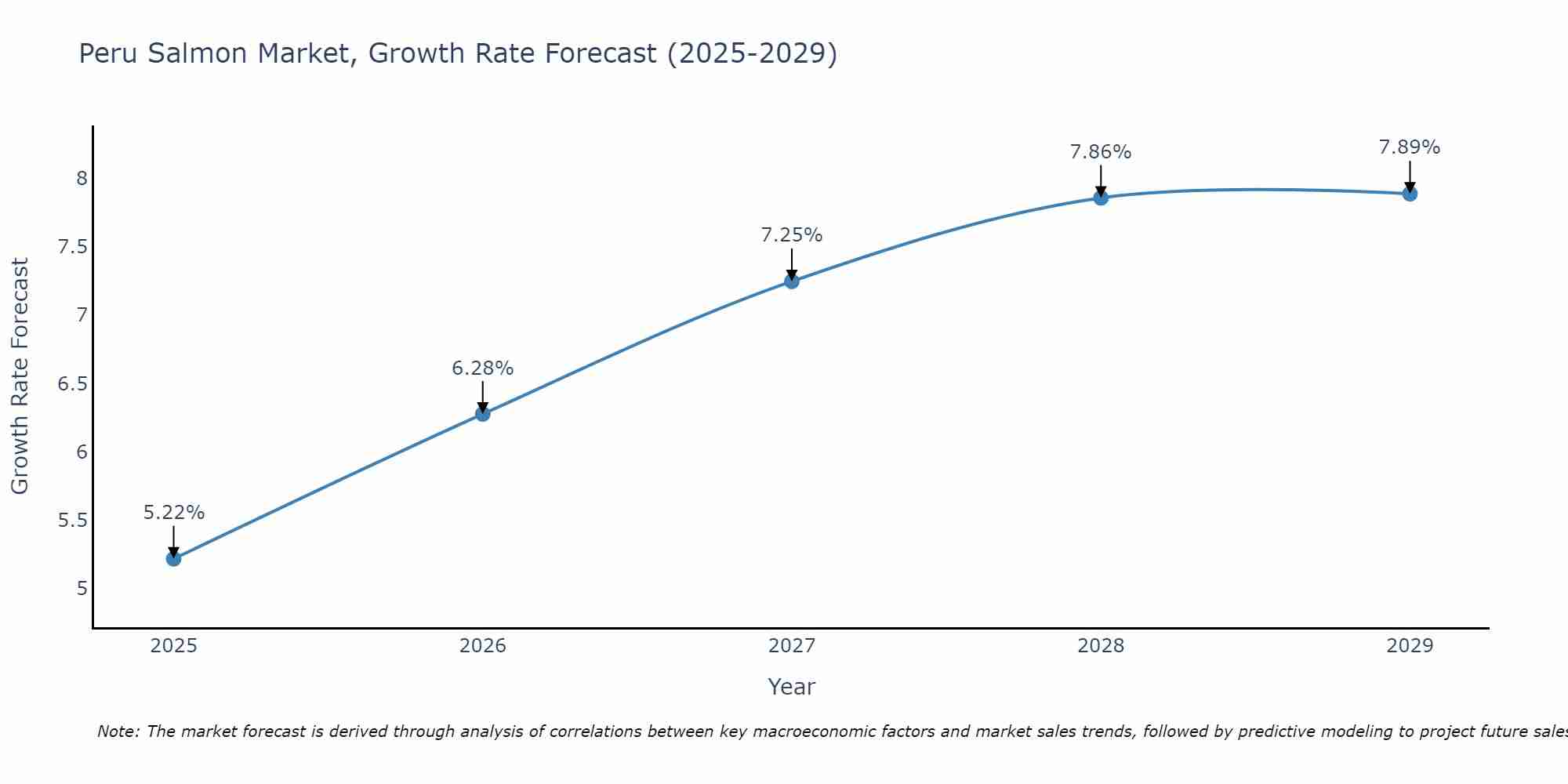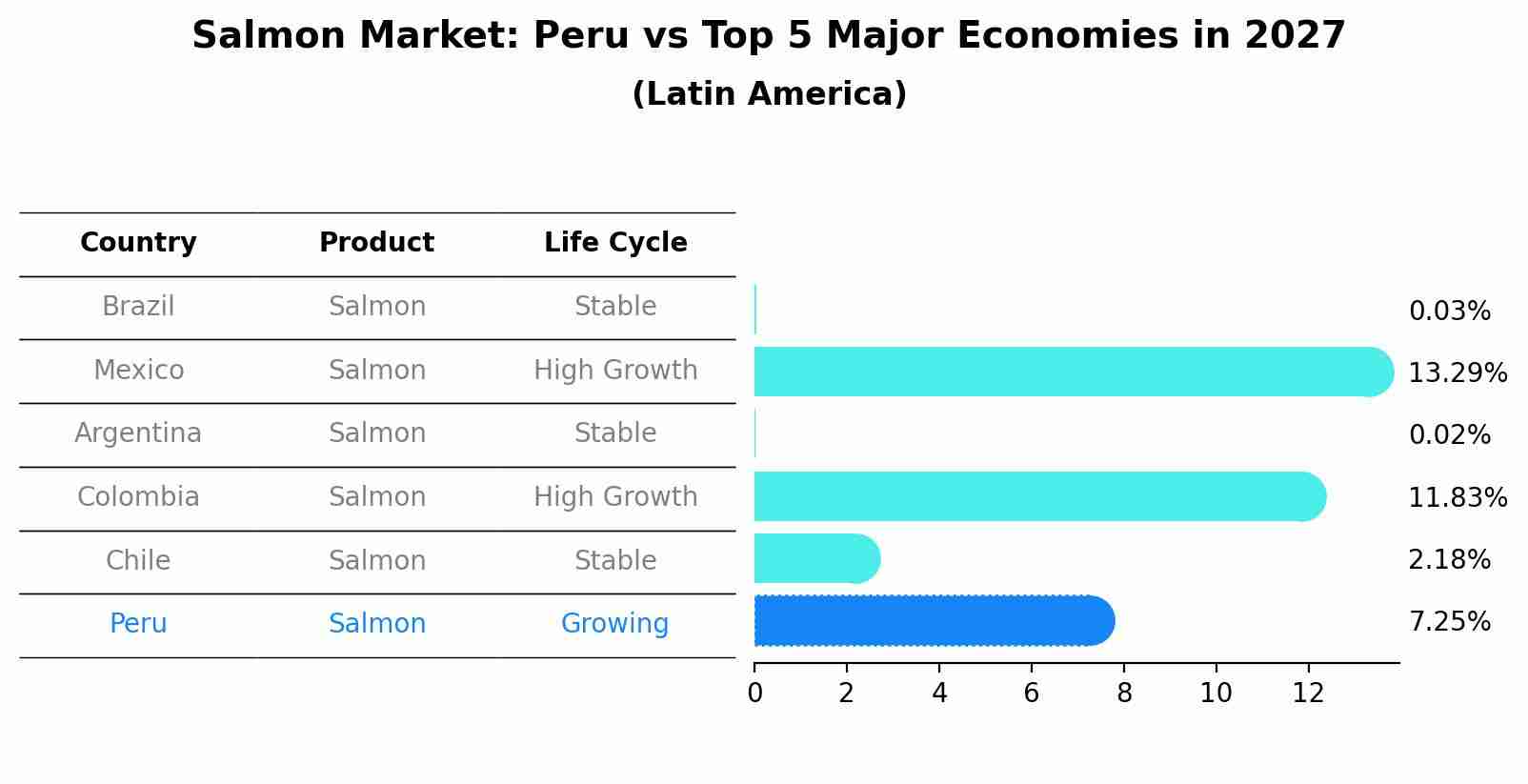Peru Salmon Market (2025-2031) Outlook | Industry, Companies, Trends, Analysis, Forecast, Value, Growth, Share, Revenue & Size
| Product Code: ETC387606 | Publication Date: Aug 2022 | Updated Date: Jul 2025 | Product Type: Market Research Report | |
| Publisher: 6Wresearch | Author: Vasudha | No. of Pages: 75 | No. of Figures: 35 | No. of Tables: 20 |
Peru Salmon Market Size Growth Rate
The Peru Salmon Market is likely to experience consistent growth rate gains over the period 2025 to 2029. Commencing at 5.22% in 2025, growth builds up to 7.89% by 2029.

Salmon Market: Peru vs Top 5 Major Economies in 2027 (Latin America)
By 2027, the Salmon market in Peru is anticipated to reach a growth rate of 7.25%, as part of an increasingly competitive Latin America region, where Brazil remains at the forefront, supported by Mexico, Argentina, Colombia and Chile, driving innovations and market adoption across sectors.

Peru Salmon Market Synopsis
The Peru salmon market has been experiencing steady growth in recent years, driven by increasing demand for salmon products both domestically and internationally. The country`s favorable climate and environmental conditions have allowed for successful salmon farming operations along its coast. Peru`s salmon industry is primarily concentrated in the regions of Piura, La Libertad, Ancash, and Lima. The market is mainly dominated by a few key players who have invested in modern aquaculture techniques to ensure high-quality salmon production. The export market plays a significant role in the industry, with countries like the United States, Japan, and Europe being major importers of Peruvian salmon products. Government support and initiatives promoting sustainable aquaculture practices further contribute to the growth and development of the Peru salmon market.
Peru Salmon Market Trends
In the Peru Salmon Market, there is a growing demand for sustainably sourced salmon due to increasing consumer awareness of environmental and social responsibility. Consumers are seeking out products that are certified as environmentally friendly and ethically produced. Additionally, there is a trend towards higher quality salmon products, with a focus on premium cuts and value-added seafood products. Health and wellness considerations are also influencing consumer choices, leading to a preference for salmon as a nutritious protein option. Technological advancements in aquaculture practices are improving efficiency and sustainability in salmon farming operations in Peru, positioning the country as a competitive player in the global salmon market. Overall, the Peru Salmon Market is evolving towards more sustainable practices, higher quality products, and greater consumer consciousness.
Peru Salmon Market Challenges
In the Peru Salmon Market, challenges include environmental concerns related to salmon farming, such as water pollution and disease control. Regulatory issues, especially concerning sustainability and compliance with international standards, pose obstacles for market growth. Additionally, competition from other countries exporting salmon to key markets can impact Peru`s market share and pricing competitiveness. Infrastructure limitations, such as inadequate transportation and cold chain facilities, can hinder the efficient distribution of salmon products. Economic factors like fluctuating exchange rates and production costs also contribute to the challenges faced by stakeholders in the Peru Salmon Market. Overall, addressing these challenges will be crucial for the sustainable development and expansion of Peru`s salmon industry.
Peru Salmon Market Investment Opportunities
The Peru Salmon Market presents promising investment opportunities due to its significant growth potential driven by increasing global demand for salmon products. With its favorable geographical location for fish farming, Peru has been ramping up its aquaculture industry, particularly in the production of Atlantic salmon. Investors can capitalize on this trend by investing in salmon farming companies operating in Peru, which offer a strong competitive advantage in terms of lower production costs and access to high-quality seafood markets. Additionally, the sustainable practices adopted by Peruvian salmon farms further enhance the market`s attractiveness to environmentally-conscious investors. Overall, the Peru Salmon Market represents a lucrative investment option for those looking to tap into the growing demand for premium seafood products worldwide.
Jordan Agar Market Government Policies
Government policies related to the Peru Salmon Market include regulations on environmental sustainability, aquaculture practices, and export standards. The Ministry of Production oversees the industry, focusing on promoting responsible growth and ensuring compliance with international quality and safety standards. Additionally, the Ministry of Agriculture and Irrigation provides support for aquaculture development, including technical assistance and funding opportunities. The Peruvian government has also implemented measures to control disease outbreaks and prevent the spread of pathogens in salmon farms. Overall, the government aims to maintain a competitive and sustainable salmon industry in Peru through stringent regulations and support for industry development.
Peru Salmon Market Future Outlook
The future outlook for the Peru Salmon Market appears promising, driven by increasing demand for salmon products both domestically and internationally. The industry is poised for growth due to factors such as favorable government policies, advancements in aquaculture technology, and a focus on sustainability practices. Peru`s reputation for producing high-quality salmon is expected to further boost its market position and attract more consumers. Additionally, rising health consciousness among consumers and the popularity of salmon as a healthy protein source are likely to contribute to the market`s expansion. Overall, the Peru Salmon Market is anticipated to experience steady growth in the coming years, offering opportunities for producers and stakeholders to capitalize on the growing demand for salmon products.
Key Highlights of the Report:
- Peru Salmon Market Outlook
- Market Size of Peru Salmon Market, 2024
- Forecast of Peru Salmon Market, 2031
- Historical Data and Forecast of Peru Salmon Revenues & Volume for the Period 2021 - 2031
- Peru Salmon Market Trend Evolution
- Peru Salmon Market Drivers and Challenges
- Peru Salmon Price Trends
- Peru Salmon Porter's Five Forces
- Peru Salmon Industry Life Cycle
- Historical Data and Forecast of Peru Salmon Market Revenues & Volume By Type for the Period 2021 - 2031
- Historical Data and Forecast of Peru Salmon Market Revenues & Volume By Chinook Salmon for the Period 2021 - 2031
- Historical Data and Forecast of Peru Salmon Market Revenues & Volume By Coho Salmon for the Period 2021 - 2031
- Historical Data and Forecast of Peru Salmon Market Revenues & Volume By Pink Salmon for the Period 2021 - 2031
- Historical Data and Forecast of Peru Salmon Market Revenues & Volume By Red Salmon for the Period 2021 - 2031
- Historical Data and Forecast of Peru Salmon Market Revenues & Volume By Salmo Salar for the Period 2021 - 2031
- Historical Data and Forecast of Peru Salmon Market Revenues & Volume By Silverbrite Salmon for the Period 2021 - 2031
- Historical Data and Forecast of Peru Salmon Market Revenues & Volume By End Product Type for the Period 2021 - 2031
- Historical Data and Forecast of Peru Salmon Market Revenues & Volume By Fresh for the Period 2021 - 2031
- Historical Data and Forecast of Peru Salmon Market Revenues & Volume By Frozen for the Period 2021 - 2031
- Historical Data and Forecast of Peru Salmon Market Revenues & Volume By Canned for the Period 2021 - 2031
- Historical Data and Forecast of Peru Salmon Market Revenues & Volume By Others for the Period 2021 - 2031
- Historical Data and Forecast of Peru Salmon Market Revenues & Volume By Distribution Channel for the Period 2021 - 2031
- Historical Data and Forecast of Peru Salmon Market Revenues & Volume By Retail Stores for the Period 2021 - 2031
- Historical Data and Forecast of Peru Salmon Market Revenues & Volume By Hypermarket/supermarket for the Period 2021 - 2031
- Historical Data and Forecast of Peru Salmon Market Revenues & Volume By Online Sales Channels for the Period 2021 - 2031
- Peru Salmon Import Export Trade Statistics
- Market Opportunity Assessment By Type
- Market Opportunity Assessment By End Product Type
- Market Opportunity Assessment By Distribution Channel
- Peru Salmon Top Companies Market Share
- Peru Salmon Competitive Benchmarking By Technical and Operational Parameters
- Peru Salmon Company Profiles
- Peru Salmon Key Strategic Recommendations
Frequently Asked Questions About the Market Study (FAQs):
- Single User License$ 1,995
- Department License$ 2,400
- Site License$ 3,120
- Global License$ 3,795
Search
Thought Leadership and Analyst Meet
Our Clients
Related Reports
- Canada Oil and Gas Market (2026-2032) | Share, Segmentation, Value, Industry, Trends, Forecast, Analysis, Size & Revenue, Growth, Competitive Landscape, Outlook, Companies
- Germany Breakfast Food Market (2026-2032) | Industry, Share, Growth, Size, Companies, Value, Analysis, Revenue, Trends, Forecast & Outlook
- Australia Briquette Market (2025-2031) | Growth, Size, Revenue, Forecast, Analysis, Trends, Value, Share, Industry & Companies
- Vietnam System Integrator Market (2025-2031) | Size, Companies, Analysis, Industry, Value, Forecast, Growth, Trends, Revenue & Share
- ASEAN and Thailand Brain Health Supplements Market (2025-2031) | Strategy, Consumer Insights, Analysis, Investment Trends, Opportunities, Growth, Size, Share, Industry, Revenue, Segments, Value, Segmentation, Supply, Forecast, Restraints, Outlook, Competition, Drivers, Trends, Demand, Pricing Analysis, Competitive, Strategic Insights, Companies, Challenges
- ASEAN Bearings Market (2025-2031) | Strategy, Consumer Insights, Analysis, Investment Trends, Opportunities, Growth, Size, Share, Industry, Revenue, Segments, Value, Segmentation, Supply, Forecast, Restraints, Outlook, Competition, Drivers, Trends, Demand, Pricing Analysis, Competitive, Strategic Insights, Companies, Challenges
- Europe Flooring Market (2025-2031) | Outlook, Share, Industry, Trends, Forecast, Companies, Revenue, Size, Analysis, Growth & Value
- Saudi Arabia Manlift Market (2025-2031) | Outlook, Size, Growth, Trends, Companies, Industry, Revenue, Value, Share, Forecast & Analysis
- Uganda Excavator, Crane, and Wheel Loaders Market (2025-2031) | Strategy, Consumer Insights, Analysis, Investment Trends, Opportunities, Growth, Size, Share, Industry, Revenue, Segments, Value, Segmentation, Supply, Forecast, Restraints, Outlook, Competition, Drivers, Trends, Demand, Pricing Analysis, Competitive, Strategic Insights, Companies, Challenges
- Rwanda Excavator, Crane, and Wheel Loaders Market (2025-2031) | Strategy, Consumer Insights, Analysis, Investment Trends, Opportunities, Growth, Size, Share, Industry, Revenue, Segments, Value, Segmentation, Supply, Forecast, Restraints, Outlook, Competition, Drivers, Trends, Demand, Pricing Analysis, Competitive, Strategic Insights, Companies, Challenges
Industry Events and Analyst Meet
Whitepaper
- Middle East & Africa Commercial Security Market Click here to view more.
- Middle East & Africa Fire Safety Systems & Equipment Market Click here to view more.
- GCC Drone Market Click here to view more.
- Middle East Lighting Fixture Market Click here to view more.
- GCC Physical & Perimeter Security Market Click here to view more.
6WResearch In News
- Doha a strategic location for EV manufacturing hub: IPA Qatar
- Demand for luxury TVs surging in the GCC, says Samsung
- Empowering Growth: The Thriving Journey of Bangladesh’s Cable Industry
- Demand for luxury TVs surging in the GCC, says Samsung
- Video call with a traditional healer? Once unthinkable, it’s now common in South Africa
- Intelligent Buildings To Smooth GCC’s Path To Net Zero


















